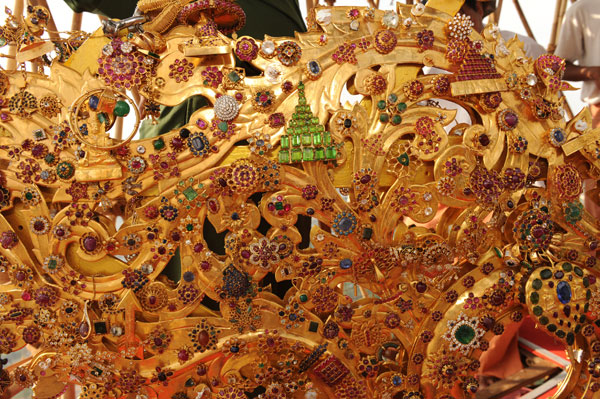The Shwedagon Pagoda
No visit to the Union of Myanmar is complete without a visit to the 2,600 years old Shwedagon Pagoda, which enshrines strands of Buddha's hair and other holy relics. Located west of the Royal Lake on 114 -acre Singuttara Hill in Yangon, Shwedagon Pagoda is the most sacred and impressive Buddhist site for the people of the Union of Myanmar.
History of the Shwedagon Pagoda
According to legend, the Shwedagon Pagoda was constructed more than 2,600 years ago, which would make it the oldest Buddhist stupa in the world. Currently scholarly research by historians and archaeologists indicate that the pagoda was first built between the 6th and 10th centuries AD. It is known that when Shwedagon Pagoda was first built, it was only 8.2 meters high. However, after a series of rebuilts and renovations by Burmese kings and queens in history, the Shwedagon Pagoda today stands close to 100 meters.
Enshrined Relics of the Pagoda
According to local chronologies dating from the14th century CE, the Shwedagon is believed to enshrine the bodily relics of the historical Buddha, Gautama, as well as artifactual relics purported by long tradition to be associated with the three other most recent previous Buddhas of our present era (kalpa).The enshrined relics include: eight strands of hair from the head of Gautama Buddha, as well as a piece of the robe believed to have belonged to Kassapa Buddha, a water filter attributed to Konagamana Buddha, and the staff of Kakusandha Buddha.
Composition and Parts of Shwedagon Pagoda
Shwedagon Pagoda is a solid brick stupa (Buddhist reliquary) that is completely covered with gold. It rises 326 feet (99 meters) on a hill 168 feet (51 meters) above the city. The perimeter of the base of the Pagoda is 1,420 feet. 326 feet above the platform.
The base is surrounded by 64 small pagodas with four larger. one in the center of each side. There also are 4 sphinxes. one at each corner with 6 leogryphs. 3 on each side of them. Projecting beyond the base of the Pagoda,
one on the center of each side are Tazaungs in which are images of the Buddha and where offerings are made.
There are four entrances leading into the base of this great Shwedagon Pagoda. No one is sure what is inside. According to some legendary tales,
there are flying and turning swords that never stop. which protect the pagoda from intruders; some says there are even underground tunnels that leads to Pagan and Thailand.
The 10 Parts of Shwedagon Pagoda are: 1) The Diamond Bud (Sein-phoo); 2) The Vane; 3) The Crown (Htee); 4) The Plantain Bud-Shaped Bulbous Spire (Hnet-pyaw-phu); 5) The Ornamental Lotus Flower (Kyar-lan); 6) The Embossed Bands (Bang-yit); 7)
The Inverted Bowl (Thabeik); 8) The Bell (Khaung-laung-pon); 9) The 3 Terraces (Pichayas); 10) The Base.
Shwedagon Pagoda is covered with hundreds of gold plates weighing around 60 tons. The spire, embedded with 5,448 diamonds, 2,317 rubies and other gemstones including topaz and sapphire, is truly a dazzling piece.
It is topped by a golden hti (finial ornament) festooned with 1,065 bells and crowned by a 72-carat diamond. It is clearly one of the wonders of the religious world.
Architecture of Shwedagon Pagoda
The traditional history, the architectural development and the artistic features of Shwedagon Pagoda demonstrate an important interchange of Buddhist architecture, art, and iconography with South Asia over several centuries.
The decoration of the pavilions on the ascending platforms on the approach to the topmost stupa narrate numerous Asian religious texts, notably those depicting the life and previous lives of Gautama Buddha, in his search for enlightenment – a spiritual journey re-enacted by all devotees who visit the Shwedagon.
The four broad covered staircases rise across three intermediary platforms lined with hundreds of monasteries and donation halls encircling the ascending levels of Singuttara Hill. The integration of the hill, the monasteries, the stupa and the art and architecture of the platform pavilions embody the creative genius of
Buddhist teachers in the design of public space where pilgrims can participate in communal rituals, chanting sermons and silent prayers, connecting the physical icon and the intangible experience.
The Shwedagon Pagoda on the summit of Singuttara Hill is a unique masterpiece of Buddhist architecture, adapting a natural hill, imbued with sacred significance since time immemorial, into one of the most iconic historic Buddhist stupas of the world.
There is little wonder that the Shwedagon is referred to in Myanmar as "The crown of Burma." Shwedagon Pagoda is a repository of the best in Myanmar heritage – architecture, sculpture and arts.


